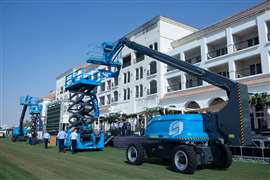Earthmoving machine uncertainty
09 November 2015
Uncertainty over whether earthmoving machinery meets statutory requirements is causing problems for manufacturers and operators, according to the German manufacturers’ trade organisation.
The VDMA (Verband Deutscher Maschinen- und Anlagenbau) said this had been the case since a warning issued by the EU Commission in relation to the requirements set out in European standard EN 474-1 on visibility for earthmoving machinery came into effect on 28 January this year.
This has led to confusion over meeting the statutory requirements and the measures required for safe operation and, consequently, operation in compliance with applicable regulations, said the VDMA.
For manufacturers, it said, the warning meant that it could no longer be assumed for any earthmoving machinery placed on the market after this date that statutory requirements about visibility would be satisfied by meeting the requirements set out in EN 474-1.
The so-called presumption of conformity does not apply, it said.
The VDMA felt that this could give rise to considerable problems, especially in case of legal proceedings.
“Since the presumption no longer applies,” it said, “the manufacturer may under certain circumstances have to prove that the precautions he has taken within the framework of the risk assessment were sufficient, in other words that he is not at fault.”
It added, “Similar considerations apply to machinery operators.”
It said that where an accident occurred as a result of an inadequate risk assessment, this could have significant consequences.
The standards committee was said to be working currently on the revision of EN 474-1. The VDMA said that committee had indicated that completion and the lifting of the warning were not to be expected before late 2016.
Position paper
To provide manufacturers and operators with help in the intervening period, the VDMA has issued a position paper which, among other things, provides detailed explanations of the statutory obligations with which the manufacturer must comply. This includes the documentation involved and, as a consequence, the drawing up of the declaration of conformity.
The responsible EU committee has suggested five points, which the VDMA recommends should immediately be taken into account in the risk assessment.
These five points are that direct visibility must have priority; near field visibility must be improved by lowering the test specimen from 1.5m to 1.0m; visibility aids such as camera monitor systems or mirrors must be mounted in the forward direction; visibility aids must not be impaired by movable machinery parts – the excavator arm, for example; and mirror-to-mirror systems are not permitted.
The VDMA position paper suggests that if certain machines do not comply with these criteria, measures should be selected which are state of the art and comply with the protection objectives “as much as possible”.
The VDMA gave an explicit warning against what it called “putative panaceas”. It said the camera monitor systems available on the market could not be considered safety systems, but only comfort or assistance systems.
It said they could not replace construction site organisation and communication.
The visibility maps currently being discussed were also viewed critically. These are intended to show the driver which areas could not be seen at all or could only be seen with difficulty. The VDMA said that it had not yet been proved that these led to better safety. The position paper also set out other arguments against their effectiveness.
Operators and employers are advised by the VDMA to check their risk assessments meticulously for each machine application and to update them where necessary.
During the current transitional period, there should be an emphasis on organisational and personal protective measures, it said. This could include increased use of human guides and the adjustment of construction site organisation.
The VDMA position paper also suggests referring to the rules of the Employers’ Liability Insurance Association for the Construction Industry concerning earthmoving machinery (BGR 500, Clause 2.12) and the document published by the Federal Institute for Occupational Safety & Health – Information on Occupational Safety 2111.
It added that operators could also contact the machinery manufacturers to obtain further information.






